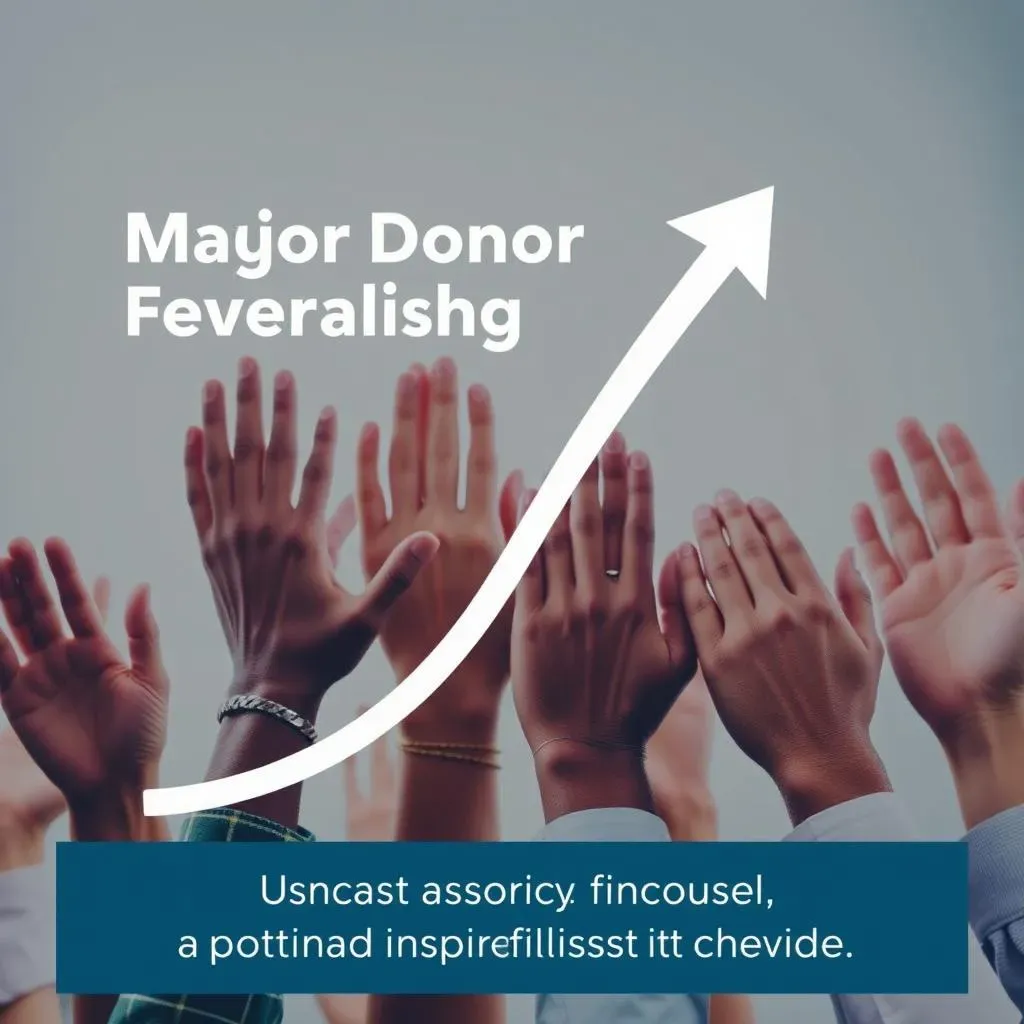Table of Contents
Securing substantial funding is crucial for any non-profit striving to make a real impact. Major donors represent a powerful source of this funding, offering the potential to significantly boost your organization's resources and reach. This article serves as your comprehensive guide to mastering the art of major donor fundraising strategies for non-profits. We'll explore essential strategies, from identifying potential donors and building lasting relationships to effectively measuring your progress and adapting your approach for optimal success. We'll delve into the practical steps you can take to cultivate meaningful connections with potential major donors, transforming initial interactions into long-term partnerships. You'll learn how to create a compelling narrative that resonates with potential donors, showcasing the tangible impact of their contributions. Further, we'll equip you with the tools and insights to track your progress, analyze your results, and refine your strategies to maximize your fundraising potential. By the end, you'll possess the knowledge and confidence to implement effective major donor fundraising strategies for non-profits, ensuring the continued success and growth of your organization.
Essential Major Donor Fundraising Strategies for NonProfits

Essential Major Donor Fundraising Strategies for NonProfits
Identifying Potential Major Donors
First things first: you need to find those big-hearted, deep-pocketed individuals who are passionate about your cause. This isn't about randomly emailing everyone; it's about strategic identification. Look at your existing donor base – who's already giving generously? Are there businesses or foundations aligned with your mission that might be interested in a major gift? Don't forget about legacy giving – planned gifts can provide a significant boost to your long-term funding. Effective prospect research is key; it involves carefully examining potential donors' backgrounds, giving histories, and philanthropic interests. This helps you tailor your approach to each individual, making your outreach more impactful.
Remember, building relationships takes time. It's not a quick win, but a marathon. Think of it like building a really, really awesome Lego castle; it takes time and effort to get to the final result. You need to nurture these relationships, showing them the incredible work you do and how their contributions directly benefit your mission. For more tips on building relationships, check out our guide on engaging donors.
Prospect Research Method | Description | Example |
|---|---|---|
Donor Databases | Online databases containing information on donors' giving history and wealth. | GuideStar, WealthEngine |
Social Media Research | Identifying potential donors through their online presence. | LinkedIn, Facebook |
Networking Events | Meeting potential donors at industry events and conferences. | Nonprofit conferences, community gatherings |
Crafting a Compelling Case for Support
Once you've identified potential major donors, it's time to craft a compelling case for support. This isn't just about asking for money; it's about telling a story. Show them the impact of your work – use powerful storytelling, statistics, and testimonials to illustrate the difference you're making in people's lives. Think about what truly motivates people to give generously. Is it the emotional connection to your cause? Is it the tangible results you've achieved? Highlight these aspects in your communications. A well-crafted proposal should clearly articulate your organization's mission, your impact, and how a major gift will help you achieve your goals. Make sure it's easy to understand, visually appealing and, most importantly, authentic.
Consider personalizing your approach. Generic emails won't cut it. Take the time to research each potential donor and tailor your message to their specific interests and values. You might even want to create a personalized video message, showing your genuine enthusiasm for your cause. A personal touch can go a long way in building a strong relationship with a potential major donor. Check out our post on effective storytelling for more tips.
- Clearly define your organization's mission and impact.
- Use compelling storytelling to connect with donors emotionally.
- Provide concrete examples of how a major gift will make a difference.
- Personalize your communication to resonate with each donor's values.
Building Long-Term Relationships
Securing a major gift is just the beginning. Building a lasting relationship with your major donors is essential for sustained support. Think of it as cultivating a garden – you need to nurture your plants regularly to ensure they thrive. Regular communication is key – keep your donors updated on your progress, share success stories, and invite them to participate in your organization's events. Show appreciation for their generosity – a simple thank-you note goes a long way, but consider more substantial gestures, such as an invitation to a special event or a personal phone call. Make them feel valued and involved in your mission.
Transparency is also crucial. Be open and honest about how you're using their donations. Provide regular reports on your organization's financial performance and the impact of their contributions. This fosters trust and ensures that your donors feel confident in their investment. Building lasting relationships takes time and effort, but it's worth it. Loyal major donors can provide consistent support for years to come, helping your organization achieve its long-term goals. Learn more about donor retention with our article on retaining donors.
Cultivating Relationships: The Heart of Major Donor Fundraising Strategies

Cultivating Relationships: The Heart of Major Donor Fundraising Strategies
Building Bridges, Not Just Asking for Money
Forget the transactional approach; cultivating relationships with major donors is about building genuine connections. It's about understanding their passions, motivations, and what truly drives their philanthropy. Think of it like building a friendship – you wouldn't just ask for a favor the first time you met someone, would you? You'd get to know them, share common interests, and build trust over time. The same principle applies to major donor cultivation. It requires consistent effort, personalized communication, and a genuine interest in their lives, beyond just their financial capacity. Start by inviting them to exclusive events or offering behind-the-scenes tours of your organization's work to provide a more personal touch. You'll also want to keep in mind their preferences and tailor your communication to them to make sure you don't come off as generic.
Regular communication is key. Don't just contact them when you need money. Share updates on your organization's progress, celebrate successes, and highlight the impact of their contributions. Send personalized thank-you notes, hand-written if possible, expressing your sincere gratitude for their support. Remember, they're not just giving money; they're investing in a cause they believe in. Nurturing this belief is essential for cultivating long-term relationships. For more insights into donor engagement strategies, explore our guide on donor engagement.
- Personalized thank-you notes and calls
- Regular updates on organizational progress
- Invitations to exclusive events and tours
- Sharing success stories and impact reports
Understanding Donor Motivations
Every major donor is unique, with their own set of values, priorities, and philanthropic goals. Before you even think about asking for a donation, take the time to understand what motivates them to give. What causes are they passionate about? What kind of impact are they hoping to make? What are their preferred methods of giving (e.g., cash, in-kind donations, planned giving)? This information will be crucial in tailoring your approach and crafting a compelling narrative that resonates with their personal values. Consider conducting in-depth interviews to delve into their philanthropic journey and understand what truly inspires them. This level of personalization will demonstrate your respect for their time and will help you craft a proposal that genuinely speaks to their heart.
Remember, major donors aren't just writing checks; they're looking for a partnership, a chance to make a meaningful contribution to a cause they care about. By understanding their motivations, you can position your organization as the ideal partner to help them achieve their philanthropic goals. This approach fosters a deeper connection, building trust and strengthening the foundation for a long-term relationship. This will also help you craft a proposal that resonates with their personal values, goals, and interests which can help you secure a major gift. For additional guidance on effective storytelling, check out our resource on nonprofit storytelling.
Donor Motivation | How to Address | Example |
|---|---|---|
Passion for a specific cause | Highlight the alignment between their passion and your organization's mission. | "Your dedication to environmental conservation deeply resonates with our mission..." |
Desire for tangible impact | Showcase concrete results and the measurable impact of your work. | "Your contribution will directly fund our program, providing clean water to 100 families." |
Legacy building | Emphasize the lasting impact of their gift through planned giving options. | "Leave a lasting legacy by establishing an endowment fund in your name." |
Measuring Success and Adapting Major Donor Fundraising Strategies for NonProfits

Measuring Success and Adapting Major Donor Fundraising Strategies for NonProfits
Setting Measurable Goals and Key Performance Indicators (KPIs)
Before you even start, you need clear, measurable goals. What are you hoping to achieve with your major donor fundraising efforts? Are you aiming for a specific dollar amount? Are you trying to increase the number of major donors? Defining these goals is crucial for tracking your progress and measuring success. Once you've established your goals, identify key performance indicators (KPIs) to track your progress. These could include the number of major gifts received, the average gift size, the number of new major donors acquired, and the overall fundraising revenue from major donors. Regularly monitoring these KPIs will help you assess the effectiveness of your strategies and identify areas for improvement.
Regular reporting is essential to keep your team and your board informed. Create a system for tracking your KPIs and generating regular reports. These reports should highlight your progress towards your goals, identify any challenges or roadblocks, and provide recommendations for adjustments to your strategies. Remember, fundraising is a dynamic process, and regular reviews will help you stay agile and adapt to changing circumstances. For more on successful fundraising campaigns, check out our tips for successful crowdfunding.
- Define specific, measurable, achievable, relevant, and time-bound (SMART) goals.
- Identify key performance indicators (KPIs) to track progress.
- Establish a system for regular reporting and analysis.
Analyzing Data and Identifying Areas for Improvement
Once you have data on your KPIs, it's time to analyze it. What trends are emerging? Which strategies are working well, and which ones are falling short? This analysis will help you identify areas for improvement in your major donor fundraising efforts. For instance, if you notice that your average gift size is lower than expected, you might need to refine your messaging or adjust your solicitation strategies. If you're not acquiring enough new major donors, you might need to enhance your prospect research or improve your cultivation efforts. The key is to be data-driven in your decision-making, using the insights you gain from your analysis to inform your future actions.
Don't be afraid to experiment with different approaches. What works for one organization may not work for another. Try different communication channels, different messaging styles, and different cultivation strategies to see what resonates best with your potential major donors. Regularly evaluate the effectiveness of your experiments and make adjustments based on your findings. Remember, fundraising is an iterative process; continuous improvement is key to long-term success. For more on fundraising strategies, check out our guide to nonprofit fundraising strategies.
KPI | Analysis | Actionable Insight |
|---|---|---|
Average gift size | Low average gift size | Refine messaging, adjust solicitation strategies |
Number of new major donors | Low number of new donors | Enhance prospect research, improve cultivation efforts |
Donor retention rate | High attrition rate | Strengthen stewardship efforts, improve communication |
Adapting Strategies and Continuous Improvement
Based on your data analysis, you'll need to adapt your strategies. This might involve refining your messaging, adjusting your solicitation techniques, or changing your cultivation approach. Perhaps you need to diversify your communication channels, incorporating social media or video into your outreach. Maybe you need to create a stronger case for support, highlighting the tangible impact of your work in more detail. Or perhaps you need to improve your donor stewardship efforts, ensuring that your major donors feel valued and appreciated. The key is to be flexible and willing to adapt your strategies based on what you learn.
Continuous improvement is vital in major donor fundraising. Regularly review your goals, KPIs, and strategies. Seek feedback from your team and your board to identify areas for improvement. Stay up-to-date on the latest trends and best practices in the field. By embracing a culture of continuous improvement, you'll ensure that your major donor fundraising efforts remain effective and efficient, maximizing your organization's fundraising potential. For examples of successful fundraising, look at our collection of nonprofit success stories.
